THE BEST ALL AROUND CARBON DISC WHEELSET

In this review, I’ll share our reviews and give you my ratings of the leading all-around carbon disc wheelsets that perform well on a wide range of road terrain and racing disciplines.
TL;DR (click for more)
- All-around carbon disc wheelsets, now in their 4th generation, are faster, more comfortable, and do more things well on a wider range of terrain than the best carbon rim brake wheels ever did.
- When choosing between these wheels, their versatility, aero drag (momentum), sidewind stability, lateral stiffness, vertical compliance, and responsiveness matter most for similarly priced models.
- We rate the Zipp 454 NSW (available here, here, here, and here) and the ENVE SES 4.5 (available here, here, here, here, and here) our best performing and recommended all-around carbon disc wheelsets.
- You can compare the performance ratings, prices, and specs of all the wheelsets in this category including all-arounders from Bontrager, Cadex, Campagnolo, DT Swiss, Shimano, and Roval.
- For budget-priced carbon all-around wheels, see my reviews of the Best Value Carbon Wheels.
In The Know Cycling is ad-free, subscription-free, and reader-supported. If you want to help keep it rolling without any added cost to you, buy your gear and kit after clicking the store links on the site. When you do, we may earn an affiliate commission that will help me cover the expenses to create and publish our independent, comprehensive and comparative reviews. Thank you, Steve. Learn more.
Related
How To Choose The Right Wheels For You
The Best Lightweight Wheels for Climbing
How Wide Wheels and Tires Can Make You Faster
CARBON DISC WHEELSET DEVELOPMENTS
We’ve now seen a 4th generation of the evolution of carbon disc wheelsets. What started as modifications of rim brake wheels is the only new carbon wheelset choice you have.
While it’s still early in this latest generation and most carbon disc brake wheelsets available to us enthusiasts are 3rd generation ones, the 4th generation of wider, lighter, tubeless-only, and hookless rims are upon us.
Many of the latest generation wheelsets will also be less expensive than those from the prior generation and, thanks to new standards, will be easier to install tires on, though they will still not be as easy as clinchers.
Carbon Disc Wheelset Evolution 2014-2022
The most notable takeaway for me after assembling this chart is how quickly things have changed and how much the latest generation of all-around wheels for road disc bikes are different than those we rode just a few years ago on our rim brake bikes.
In fact, most of the leading wheelset companies have stopped selling carbon rim brake wheels, and all development time and money is spent on disc brake wheels. That’s why I’ve called the 4th generation “All In On Disc Brake Wheels.”
These changes have made the all-around carbon disc wheelset faster, more comfortable, more durable, and more versatile than all-around rim brake wheels ever were without any effect on stiffness, acceleration, or handling.
Remember when better braking was all that most people fixed on when talking about the benefits of going to road disc bikes? Well, the ability to get all the benefits I just summarized is a whole lot more than better braking, which was enough of a reason for many people to go with a road disc bike in the first place.
Let me go through some of these benefits a bit more.
Faster – Wider rims mean you can run some 28C tires to gain more comfort without incurring additional drag. Wider tires also reduce losses or energy that saps your body from the road vibrations that come with a narrower tire that you need to run at a higher inflation pressure to maintain the same opposing force as a wider one. (See my post on how wide wheels and wide tires can make you faster for more on this.)
Most of the Gen 3 disc brake wheelsets were designed for 25C tires that, once inflated, will be narrower than the external rim width. This makes the rim-tire combination more aero than using 28mm tires when your speeds top 20mph/32kph. And aero gains are something you pay for when buying deep or all-around carbon disc wheels.
More Comfortable – Going tubeless allows you to run your wider tires at lower pressures without pinch flat concerns. Lower pressures make for a more comfortable ride and fewer impedance losses.
More Durable – The best carbon rim brake wheels use resins with high melting points to make it much harder for riders to warp them when they apply or drag the brakes. The trade-off is that these resins can make the wheels a bit brittle. While I can’t quantify the difference, dedicated disc brake wheels use lower melting temperature resins that are less brittle.
More Versatile – Because the latest generations of all-around carbon disc wheels have gotten wider, more tubeless friendly, and more durable, you can comfortably ride them on gravel and cyclocross tracks with the appropriate tires. Those with 23mm or 25mm inside rim widths are as wide as dedicated gravel wheels. Doing this can save you from having to buy another set of wheels to excel on dirt, grass, and gravel roads and trails.
A few words about tubeless tires. You’ll notice that tubeless tires are often mentioned in my description of developments and their benefits.
Removable valve cores, easier-to-mount rims, and a whole lot more experience with tubeless tires while testing all these carbon disc wheelsets have made installing them easier and cleaner and mellowed me somewhat to the minimally more added work they bring over standard clincher tires.
Lower prices, lower rolling resistance (lower than tubular or clincher tires), the ability to run lower pressures, more comfort, and having nearly every puncture seal so far have made me look past many of my previous objections to tubeless.
While tubeless still requires a learning curve, I can now say the benefits they add to the right rims can outweigh the diminishing disadvantages and make it well worth getting up that curve if you want those benefits. My review of tubeless tires lays all of this out in more detail and gives you my recommendations for the best ones.
WHAT MATTERS MOST
For each In The Know Cycling review, I evaluate category-specific criteria in four groups – performance, design, quality, and cost. The criteria that matter most in those groups for the best all-around wheels for road disc bikes are as follows:
Performance: Versatility, specificity, aero drag (momentum), sidewind stability, lateral stiffness, vertical compliance, aka “comfort,” responsiveness, and durability.
Design: Wheel weight and material, rim depth, rim inner and outer widths, rim profile, hub and spoke design, and wheel finish.
Quality: Warranties, crash support, and service/support.
Cost: Purchase price, cost of ownership, and replacement cost.
I use most of those criteria for all-around disc brake wheelsets, with a few exceptions and changes in emphasis that I’ll point out below.
You can’t measure a wheelset’s aero drag on the road, so, as a surrogate, we evaluate and compare how well different wheelsets maintain their momentum at different speeds.
Since the latest all-around carbon disc wheelsets are deeper than earlier ones, sidewind stability has become increasingly important.
And since all-around wheels are intended for a wide range of paved road terrain – flats, rollers, climbs, descents – and for mixed or unpaved surfaces and for cyclocross racing, and even gravel, versatility is key. Specificity, or how well a wheelset performs in a specific situation, is a criterion best used for dedicated aero, climbing, or gravel wheels.
Stiffness and compliance are important for all wheels.
Responsiveness, or how lively and light your wheels feel as you accelerate and handle your bike at different speeds, across varying terrain, and through a range of cornering situations, is a key measure of all-around wheels but less in others.
Durability is obviously important for any wheelset. However, we can only measure it on an exception basis since testing one set of wheels is not representative of the performance of the many wheels a company makes of a specific model. We also don’t test it long enough to induce failure. If it fails or has issues early in our testing, or we hear or read about shops and users reporting chronic problems, we’ll certainly report that.
Design specs like weight and rim width are worth noting but may or may not deliver the intended performance those specs are often associated with. A wheelset’s actual responsiveness, stiffness, and comfort on the road, for example, are far more important than the design specifications and new technology that we often get so hung up (and sold) on and that we too easily equate to those performance attributes.
Considering the range of options the road cycling enthusiast has to choose from in all-around wheels for road disc bikes, I recommend a Best Performer (independent of price) but not a Best Value wheelset (considering performance and price) in this review. For less expensive all-around wheels which unfortunately do not perform as well, check out my review of the best value carbon wheelsets here.
Quality is either a go or no-go in my recommendations. I won’t recommend anything that doesn’t have an acceptable level of quality according to my criteria. I’m also not going to recommend something that has superior quality but under-performs or has higher costs. When two wheelsets perform more or less the same, I do consider quality and cost criteria in recommending one as a Best Performer.
With all of that noted, here are my evaluations of the best all-around carbon disc wheelsets for road cycling enthusiasts.
ALL-AROUND CARBON DISC WHEELSET COMPARATIVE RATINGS
Go directly to reviews:
Campagnolo Bora Ultra WTO 45 Disc Brake
REVIEWS AND RECOMMENDATIONS
Best Performer
ZIPP 454 NSW – FAST WHEELS ANYWHERE YOU RIDE
If you don’t want to pick between wheels that would be fast on flats vs. on rolling hills vs. on climbs or in a training ride, group ride, road race, or crit, I recommend the latest Zipp 454 NSW Tubeless Disc-brake wheelset. It will be fast in all those situations and the fastest around in many of them.
At US$4220/£3376/€3798, it better be. But if top performance in a single wheelset in nearly every situation and against nearly every criterion is important to you, it just may be worth it.
That’s the conclusion that fellow testers Nate, Miles, and I reached after riding the Zipp 454 NSW.
At its core, it’s a stiff, deep, and light wheelset. Those three attributes, along with the 454 NSW’s fast-engaging rear hub, make it so responsive that it redefines the term “snappy.”
Practically, the 454 NSW’s superior ability to accelerate made it an ideal partner for 20-30 second break-away efforts and sprint finishes. Except for on the steepest of slopes, Miles said this wheelset “made me faster on nearly any effort I tried.”
And Miles is already a fast dude, regularly winning P/1/2 masters crits, road, and stage races in the Northeast and finishing top 10 at US Nationals.
Even for me, a more average B group level roadie, the sensation of riding this highly responsive 454 NSW wheelset was energizing almost from the first pedal stroke. Once into my rides, I felt like I had great legs every day I rode them.
Nate, our A group Bullet Train ride leader who rode the 454 NSW on some of those early morning hammerfests and out front of 100 and 140-mile one-day rides with 8,000 to 10,000 feet of climbing, initially resisted giving them up for others to test. Despite being a peace-loving guy, he paraphrased Charleton Heston’s line about prying them out of his “cold dead hands.”
Nate has been testing all sorts of wheels along with me for at least the last 5+ years, including the prior generation 454 NSW rim brake wheels. His feedback started with a most definitive statement.
These are the first wheels where I haven’t felt like I was making a tradeoff between aero and climbing performance.
I don’t know what they cost (I’ve trained him not to look at price or specs and just judge performance – ed). I’m sure it will be high. But, I would put them in the category where it just MIGHT be worth paying $1,000 more for these than others which are ALMOST as good but not on all characteristics. (Nate’s capitalization.)
Unlike Nate’s experience with the earlier 454 NSW rim brake wheels that wobbled in crosswinds to the point where he slowed on each fast downhill section of a looping road race, he felt confident on similarly fast, windy descents riding this new 454 NSW disc brake wheelset.
Miles felt far less comfortable in some windy situations. When the breezes picked up to about 20 mph and came directly from the side, it felt like he was getting a slight body check and was pushed around far more than with any wheelset he’s ever ridden.
It may be that the 454 NSW’s sawtooth rim profile is best at reducing crosswinds at lesser yaw angles than what Miles experienced and perhaps more similar to those Nate did. For me, I always seem to be riding into headwinds no matter what course I’m on, and it was no different riding the 454 NSW.
The only other slight knock we had on this carbon disc wheelset was its ability to hold its momentum on the flats at speeds north of 25mph. While the 454 NSW rolled just fine at that speed, it felt like we needed a bit more effort to keep pace with the average aero wheelset that is often 5-10mm deeper and 200-300 grams heavier. It’s simply a matter of physics and a tradeoff the speediest of enthusiasts might want to keep in mind.
You are likely doing a lot of handling when you aren’t on a breakaway, going over rolling terrain, heading up climbs, or sprinting for the line. And the good news is that this is another area where the 454 NSW outperforms most wheelsets.
We experienced precise, confident, high-speed cornering. These carbon disc wheels do exactly what you want them to do in big arc turns, 50+mph downhills, slower switchbacks, and even quick, last-second movements.
With the right tires and at the right pressures, the ride is also very comfortable, no matter how good the pavement is. While many all-around wheels are similarly compliant nowadays, some wheels around the 454 NSW’s depth tend to give up comfort by using a narrower rim to keep weight down. You make no such trade-off with these Zipps.
Add to all of this a very smooth rolling hubset and almost silent, fast-engaging freehub. That makes it even more tempting to start a breakaway and easier to crank up a sprint.
The 454 NSW defies categorization. It’s the wheelset equivalent of a hors categorie climb, one that is beyond categorization.
Based on its 55 to 59 mm deep rims, you might think the Zipp 454 NSW is an aero wheelset. You wouldn’t be wrong. Judging from its 1388-gram weight, you might guess it climbs well. Indeed it does. Hookless, 23mm inside rim width will make for a very comfortable ride, right? Yes, and perhaps worthy of riding gravel, though we didn’t test it off-road.
So are these all-around wheels? Yes, that may be the most encompassing definition though it is faster and better than any all-arounder we’ve tested on terrain that never exceeds 5-6% up or down and faster than many aero wheels on the flats and climbing wheels on steeper pitches.
Perhaps it’s best to call it an all-everything wheelset. Or just fast anywhere you want to ride.
You can buy the Zipp 454 NSW using these links to BTD (BikeTiresDirect) 10% off w/code ITK10, Competitive Cyclist, Performance Bike, and Sigma Sports, all stores I recommend and rate highly for their prices, customer satisfaction, and support. You can also find it and compare prices using this link to Know’s Shop, which shows all the stores I recommend that carry this product.
Find what you're looking for at In The Know Cycling's Know's Shop
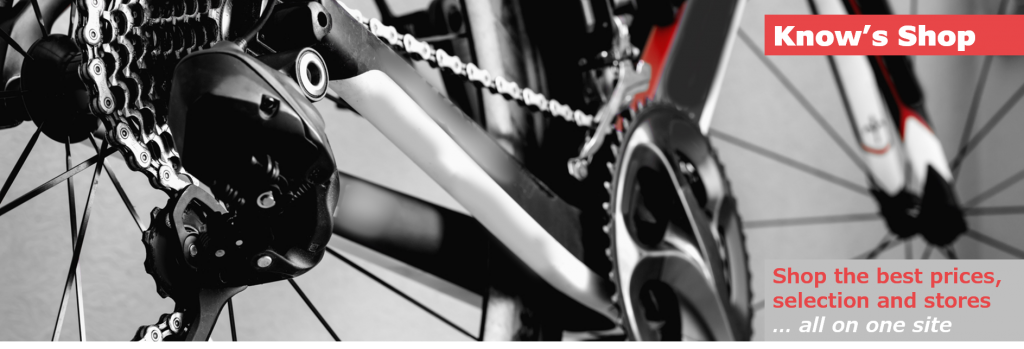
- Compare prices on in-stock cycling gear at 15 of my top-ranked stores
- Choose from over 75,000 bikes, wheels, components, clothing, electronics, and other kit
- Save money and time while supporting the site when you buy at a store after clicking on a link
Best Performer
ENVE SES 4.5 – STILL STANDS ABOVE
The second-generation ENVE SES 4.5, born the SES 4.5 AR, continues to stand above all other all-around wheels in the performance carbon disc wheelset price category (US$2000/£1600/€2000 to $3000/£2300/€3000).
In my on-the-road testing, I’ve found the SES 4.5 performs as well or better on the combination of factors I think matter most to your speed and enjoyment of road cycling wheels. It’s fast, stable, stiff, comfortable, responsive, and versatile. It’s got it all.
And it’s just a hell of a lot of fun to ride. The ENVE SES 4.5 seems to glide along the road with no drama as you accelerate from a start, transition from flats to hills, and take corners at high speed. It’s unbothered by crosswinds and coasts with nary a sound from the freehub.
To be clear, the ENVE 4.5 is no recreational stroller. Rather, it’s seriously fast, deceptively so with its relatively modest looks and quiet demeanor.
I rode the new 4.5 for the first time on a recovery ride at the end of a week of training full of hard anaerobic and VO2 max intervals. “Let’s just ease into it,” I told myself, never wanting to judge a wheelset I’m testing for the first time on a hard day in the saddle.
Despite being physically and mentally tired, riding the ENVE SES 4.5 re-energized me. It responded quickly and easily to my efforts, flowed through corners, and smoothed hills and rough roads.
As I put it through harder efforts in the days that followed – VO2 intervals, 7% climbs, and on-my-limit group rides – the 4.5’s performance helped me be at my best, or at least better than on other days with other wheels rolling beneath me.
Regardless of the specs, which I’ll get to in a minute, the ENVE SES 4.5 feels light and lively and maintains my momentum in the 20mph/32mph to 25mph/40mph speed range incredibly well.
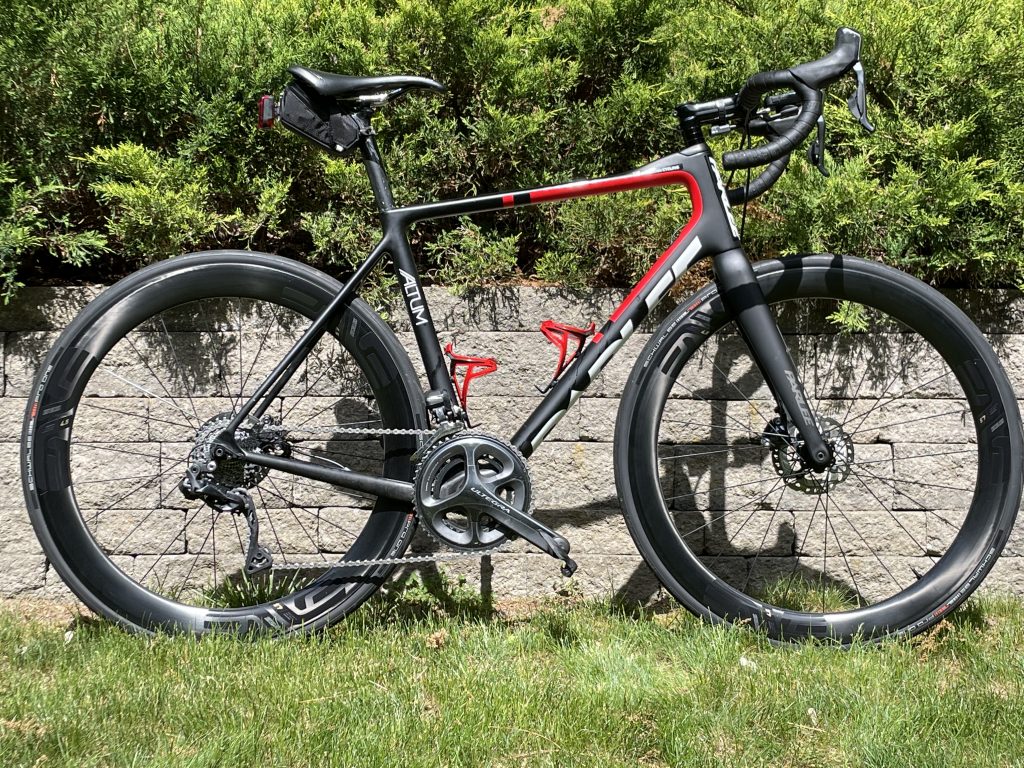
Stiff, efficient, comfortable, quiet, fast. Total confidence and total pleasure regardless of terrain, surface, effort, or speed.
It’s somewhat surprising that a second-generation wheelset, little changed from one introduced six years before, could still be the Best Performer among its all-around carbon disc wheelset peers. While others have certainly improved on individual performance criteria I use in evaluating wheels, none have reached the same level as the ENVE 4.5 across all of them.
If performance balance is a measure of all-around wheels and great performance across all criteria is the mark of the best, then the ENVE 4.5 still stands atop the rest.
My spec-obsessed evil twin always wants to get in the way of my performance-focused good twin and influence you. Well, I’ll give him some space to speak up here.
For years one of the key differences between the original 4.5 AR and most other road wheelsets was its 25mm inside width. That continues with the new 4.5 (25.3mm per my measurement) and is why I can run my tire pressure low to get the comfort I enjoy even on rough paved and dirt road surfaces. Other wheelmakers, notably Zipp and Bontrager, now make rims with 23mm inside widths for wheels of similar depth, while most other brands still make road disc brake wheelsets with a 21mm inside width.
On the outside, the 4.5 rims have widened a couple of millimeters per my measurements from the 4.5 AR to 32.8mm for the front wheel and 32.4mm for the rear. The rims have also gotten about 1.5 mm deeper, now 51.8mm front and 56.5mm rear.
The wider, deeper rims, says ENVE, come from adding their anti-pinch-flat design to the 4.5, something the SES 3.4 AR (now the SES 3.4) has had since it was introduced. Whatever, I’ll take the added width and depth if it improves the performance.
It seems so. With the slightly wider rims, more models of 28mm labeled tires can be used on the 4.5 at lower pressures to give you optimal aero drag and rolling resistance performance and better comfort across rough roads. I get into all the details of that in my tubeless tire review.
Note also that the front and rear wheels have different dimensions and also different shapes. The front wheel has a U-shaped profile designed to improve its stability in crosswinds, while the rear is deeper and has a V-shaped one to improve its aero performance.
In the last couple of years, Roval, Hunt, and Parcours have introduced wheelsets with different front and rear dimensions and profiles, though none are as wide internally as the 4.5.
ENVE’s measurements show the average SES 4.5 weighs about 100 grams less overall than the 4.5 AR did and, more importantly, their deeper, wider rims weigh about 110 grams less than the first-generation ones.
My demo ENVE 4.5 wheelset came in at 1518 grams with the Shimano/SRAM 11-speed HG freehub (a SRAM XDR 12-speed one weighs about 20 less) and with the wheels taped but with no valve stems in place. That still puts it about 50 grams heavier than the actual weights of the narrower and shallower Bontrager RSL 51 and Campagnolo Bora Ultra 45 wheelsets and 140 grams more than the US$4200 Zipp 454 NSW. The difference accelerating from a dead stop is minimally better with the Bontrager and Campy and more noticeably so with the Zipp.
While more and more rims come through pre-taped with valve stems in place these days, ENVE continues to send you tape and stems to install yourself. This video demonstrates how to install ENVE tape; ignore the part at the beginning about using clincher tires – it doesn’t apply to the current line of SES wheels.
ENVE justifies this DIY approach by wanting to give you or your retailer the option to adjust the internal nipples for spoke tension and wheel true before applying the tape that covers access to the nipples. Internal nipples reduce the drag of external ones by 0.75 watts per wheel in ENVE’s wind tunnel tests. It’s nothing to sneeze at for those who believe in marginal gains.
I don’t know about you, but even with all the wheels I test, I’ve never found the need to have a tension meter or trueing stand on my workbench. Hand and eye inspection can detect true outliers, and even with them, I’m not wrench enough to start messing with my spoke nipples.
I expect that ENVE ships very few wheels that are out of tolerance. Heck, they were among the first to offer 5-year parts and labor warranties on their wheels. So, they likely have a pretty good fix on the quality of their wheels, all of which are made in their United States factory. I would think most of us and our store mechanics would prefer ENVE tape their rims before shipping them to our doorsteps, even though some of us have become pretty good at taping them ourselves over the years.
If a wheel were to come in with spoke tension or true that’s not up to spec, I believe their warranty should pay a trained mechanic to adjust the nipples and retape the rim.
Note also that the ENVE SES 4.5 (and all current ENVE SES and Foundation wheels) use hookless rims and require tubeless tires whether you use sealant or tubes inside. Fortunately, the list of compatible tires for that combination is growing longer and longer and includes the top-performing tires from most brands. You can see the list of compatible and incompatible tires per ENVE testing.
For those of you still resistant to hookless rims because you want to be able to inflate your tires as high as you like without the worry of them blowing off, please understand a few things about the SES 4.5 wheels.
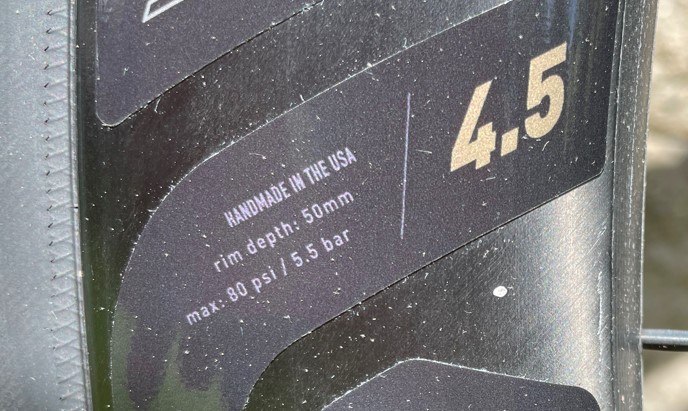 First, with the 4.5’s 25mm inside width, you won’t want to inflate your tires past the maximum recommended pressure of 80psi, even if you weigh the maximum recommended rider weight of 250lbs/113kg. They’ll be increasingly uncomfortable and slower above the recommended pressures shown in ENVE’s chart. As you can see there, it shows only 67 psi as the starting tire pressure recommended for the heaviest riders.
First, with the 4.5’s 25mm inside width, you won’t want to inflate your tires past the maximum recommended pressure of 80psi, even if you weigh the maximum recommended rider weight of 250lbs/113kg. They’ll be increasingly uncomfortable and slower above the recommended pressures shown in ENVE’s chart. As you can see there, it shows only 67 psi as the starting tire pressure recommended for the heaviest riders.
Second, ENVE has been making hookless rims and testing them with tubeless tires for years. For their 25mm inside width rims, they have established 80psi as the maximum recommended tire pressure and 90psi for their 21mm inside width hookless rims. Both of these pressure levels are higher than the ETRTO and ISO 5 bar, 72.5 psi standard for hookless rims of any width.
And ENVE only lists tires as compatible if they stay on their rims in their tests through 150% of the maximum recommended pressure. So I think there’s plenty of performance and comfort motivation to keep your tires well below the max pressure and a pretty good safety zone if you revert to your 20-year younger self in the presence of a tire pump on an off day.
Unlike earlier incarnations of SES wheels, where you could order Chris King, Industry Nine, DT Swiss, or ENVE’s own branded hub with carbon shells, there is only one hubset available on the 4.5.
Fortunately, it’s the ENVE hub with alloy hub shells, a direct drive model they’ve been putting on most of their wheels for the last few years. These are the same ones I’ve used with no issues (and performed no maintenance on) with the ENVE SES 5.6 and 3.4 AR wheelsets I bought to benchmark other brands of wheels with performance goals similar to those.
You can order the 4.5 with either an HG, XDR, or N3W freehub body compatible with your Shimano/SRAM 11-speed, SRAM AXS 12-speed, or Campagnolo groupset.
Finally, some ENVE wheelsets I’ve tested in the past have come through with hair-thin, 2-3mm long white lines in the carbon accumulated at random places along the rim’s spoke edge. While hardly visible unless you go around looking for such things (I do), I and some readers found this rather annoying and even worrisome.
The issue turns out to be only a cosmetic one, apparently caused by an oxidation side effect of the hardening agent used in the resin. While a sample size of one, the new SES 4.5 I tested had almost none of these white lines. ENVE is using a new resin in their new line of SES wheels that, in part, has enabled them to reduce the rim weight but also is supposed to address the oxidation issue that caused the white lines in the earlier resin.
We’ll keep an eye on this. Literally.
The ENVE SES 4.5 price has gone up US$300 to US$2850, and current exchange rates make it RRP £3300, €3800, though often sells for less in those currencies. It is available using these links to recommended stores BTD (BikeTiresDirect) 10% off w/code ITK10, Competitive Cyclist, Performance Bike, Merlin, and Sigma Sports. It’s hard to justify – you’ll need to make peace with your own budget watchdogs – but it’s also hard to say no to a wheelset that still stands above its competition.
BONTRAGER AEOLUS RSL 51 TLR – THE DEFINITION OF AN ALL-AROUND ROAD DISC WHEELSET
It’s easy to judge any wheelset by looking at what it does well, what it doesn’t, what it costs, and what it looks like. And, if you’re into design and engineering, add specs and tech to your evaluation.
I’ll get to much of that. But when it comes to the Bontrager Aeolus RSL 51 TLR, let me start with the bottom line.
The RSL 51 is the definition of a modern all-around road disc wheelset.
This mid-depth Bontrager does most of the things road cycling enthusiasts like you and me should look for if we can only buy one carbon disc wheelset. You can train with it at speed on various terrain, enjoy friendly competition against your buds riding hard on group rides, and do long-distance events in comfort. It doesn’t have any obvious weaknesses.
Its glossy finish and branding look good without being loud, it has a strong warranty and dealer network, and it’s priced in the same ballpark as other, less well-rounded alternatives.
The RSL 51’s specs are all modern without offending anyone. It uses the updated model of the well-established DT Swiss 240 hubs (Ratchet EXP) and has rims that are wider than most all-around carbon disc wheels (23.2mm internal, 30.7mm external), as deep as most go these days (51.1mm), and are hooked for riding with tubeless or clincher tires.
And at 1441 grams on my scale with taped rims rather than the weighty plastic rim strips installed, they are marginally lighter (about 20 to 120 grams) than most in this category.
No, the RSL 51 will not outperform a climbing wheelset going up alpine roads or aero wheels in crit race or the best gravel wheels riding off-road. For that, you’ll need all-around wheels with those strengths but other weaknesses or wheels designed uniquely for those types of events or terrain.
But, for an all-around carbon disc wheelset, my fellow testers Nate, Miles, and I found the Bontrager Aeolus RSL 51 TLR do climb quite well. Descending at high speeds is also a confident experience thanks to their excellent handling and unfazed reaction to side winds.
That good handling extends to flat roads where the RSL 51 tracked well through corners paired up with the 28c Bontrager R3 Hard-Case Lite and 25c Michelin Power Road tubeless tires we mounted on them.
Acceleration is another one of RSL 51’s strengths. Combined with their handling skills, this makes for a very responsive wheelset, important when keeping up with moves on a group ride and staying out of trouble in a paceline.
Despite their few mm of added depth, we didn’t find they were any faster or held their speed any better than other all-around disc wheels we’ve tested. And while they accelerate well and are stiff enough for mere enthusiast mortals like me, they aren’t the kind of max stiffness wheels you want for the kind of > 1000-watt sprints you might do in a crit. Bontrager does make wheels for that (see my review of the RSL62), but these aren’t them.
On long rides, the RSL 51 is quite comfortable and better than most in this category. The new DT240 Ratchet EXP hub is louder than its predecessor when freewheeling but not overly so and it’s a relatively low-frequency sound that I don’t find annoying.
At US$2700, £2100, €2500, the Bontrager Aeolus RSL 51 certainly isn’t cheap but is one of the better all-around wheels we’ve ridden. Using these links, you can order them from Bontrager and Sigma Sports.
CADEX 50 ULTRA – A GOOD OPTION FOR LUMPY RACES
The Cadex 50 Ultra’s stiffness is central to its performance. My fellow tester Miles, a P12 road racer, and I, a B-group rider, took advantage of that stiffness in a range of ways during our tests of this wheelset.
Miles used it to cover a lot of accelerations in road races and crits. During one 65-mile road race filled with surges, a promising break went away that he didn’t initially get into. He used the Cadex 50 Ultra’s stiffness on an uphill kicker to close a 10-second gap to that group.
The wheelset inspired confidence in both of us with its quick handling and precise cornering. For Miles, he could more easily pick his way through traffic in crits and dive into downhill corners in lumpy road races.
I was able to avoid a crash thanks to the Cadex 50 Ultra’s cornering precision. The rider I was following over-cooked a downhill turn and I cut a tighter radius on these wheels to safely get inside of his arc. I’m not sure I could have pulled that off with most wheelsets I’ve tested.
Add strong climbing to the list of this wheelset’s assets. Its stiff and relatively lightweight combination of rims, hubs, and carbon spokes (1402g as measured with an HG freehub) undoubtedly contributes to its ability to go uphill.
But, the Cadex 50 Ultra also has liabilities that limit its performance beyond road races and criteriums on rolling terrain.
While it helps get you up to speed very quickly, this wheelset doesn’t carry your speed as well as other, high-end race and all-around ones.
And on even moderately windy days (10 mph/16kph), I found the Cadex 50 Ultra front wheel moving all around. Perhaps they do better at higher speeds, as Miles didn’t take issue with their crosswind stability riding this wheelset during his spring training and racing season.
We both agreed that these aren’t very compliant wheels, the kind you’d find comfortable over a 3+ hour ride. As a hookless wheelset that’s wide enough (22.5mm inside width) to ride in the mid-50psi range with 28mm tubeless tires (we used Continental Grand Prix 5000 S TR) for our similar 150lb/68kg or so weight, this Cadex’s compliance was disappointing.
At 60psi, the ride was harsh. Below the low 50s, it was mushy. And at the pressures in between in search of the best combination of comfort and handling, you still feel everything through the wheels, though they don’t jolt you.
Blame the below-average compliance of the Cadex 50 Ultra on the carbon spokes Cadex uses to give it above-average responsiveness and handling. While I’ve not tested them all, I’ve yet to ride a wheelset with carbon spokes that are both laterally stiff and vertically compliant.
The freehub Cadex uses on the 50 Ultra is also louder than most. When I apologized for it to the rider in front of me in a paceline, he immediately responded, “Yeah, what is that?” While some cyclists like an audible freehub, the Cadex 50 Ultra is more vocal than a Chris King or i9 and right up there with the most boisterous of those used on the less expensive wheels coming from Chinese factories.
If you regularly compete in lumpy, punchy races where quick maneuvering and repeated accelerations are key to your performance, the Cadex 50 Ultra is a good option. For a broader range of riding and racing, there are better choices in the all-around performance wheelset category.
The Cadex 50 Ultra wheelset retails for US$3500, £2650, €2850 and is available from BTD (Bike Tires Direct) 10% off w/code ITK10, Performance Bike, and Cyclestore.
CAMPAGNOLO BORA ULTRA WTO 45 – MORE THAN SKIN DEEP
Like most Campagnolo kit, it’s hard not to be taken by the stunning beauty and engineering precision of the Bora Ultra WTO 45 wheelset. The rich black rim finish, hourglass hub shell, recessed spoke nipples, and modest yet proud graphics draw you in.
As with anything as alluring as this wheelset, I was hopeful that its performance would be just as beautiful and precise.
In some ways, it is.
Judging from how little effort is needed to get it up to speed, the Bora Ultra WTO 45 feels like a fast disc brake wheelset. It doesn’t hold that speed as easily as an aero wheelset or the fastest all-around wheels do on a flat or rolling course. But, the lively and responsive feel of this Campy makes it feel quite fast when you accelerate from a stop or out of a corner.
The Campagnolo hubs roll incredibly smoothly, and the freehub is absolutely silent. I felt alone with my thoughts doing a soul ride or set of hard interval workouts on the Bora Ultra WTO 45. For me, that’s generally a good thing. However, if you prefer being accompanied by the sounds coming out of your freehub or drivetrain, you’ll not get that kind of collaboration from this wheelset.
Equally distinctive, and perhaps more importantly, climbing well is a true partnership with these Campags. They go up ramps and steeper pitches with relative ease.
At 1445 grams on my scale with valve stems in place, the Ultra version of the Bora WTO 45 actually weighs about 70 grams less than the non-Ultra model of the Bora WTO 33 we’ve reviewed. While it doesn’t weigh as little as a pure climbing disc brake wheelset, the Ultra 45’s feel as energetic going uphill as one that is.
In addition to its climbing ability, the Bora Ultra WTO 45 wheelset is quite responsive and tracks with great precision through corners. It’s a laterally stiff setup that accelerates well when called upon. My fellow tester and competitive racer Miles found them extremely stiff compared with the other wheels he’s ridden with “zero flex” sprinting on the flats or up a steep climb.
Our test period included several days when the wind blew 15mph/25kph. In those conditions, you must work with even the most stable all-around wheels to keep things upright. Coming from the side at those wind speeds, the Bora Ultra WTO 45 also gets pushed. The front wheel leans steadily away from the wind rather than with an erratic reaction. Counter-steering in the direction of the wind got me through it.
But on milder days when the wind isn’t blowing that strong or steady, it slices through the winds and gusts quite well with no steering or stabilizing adjustment required.
While sufficiently comfortable for a race-oriented wheelset, especially with the 25mm Veloflex Corsa TLR tubeless cotton (puncture belt equipped) tires we used for this test, you can’t easily optimize them for both speed and comfort on all paved surfaces given their 19.0 mm inside, 26.3 mm outside rim dimensions.
The 25mm Veloflex and Continental Grand Prix 5000 S TR I mounted to these wheels both measure sufficiently narrower than the rim width, even at 80psi. That will give you ideal aero performance over the lifetime of the tires. The other 25mm tubeless tires and all the 28mm ones we installed on this wheelset are or will become wider than the rims and add aero drag (see measurements here).
With 25mm tires installed and at the pressure required for that width tire and your weight, Miles and I didn’t find these Campys to ride either plush or harsh. They were comfortable enough even on the 80-mile ride Miles took them on and not a noticeable benefit or drawback on the many 2-hour rides we each did.
If comfort is more important than speed or the road surface you ride is better with a wider tire inflated at lower pressure, you can certainly use 28mm tires on these wheels and perhaps make up for the added aero drag with reduced vibration loss rolling resistance depending on your speed and riding surface. But be careful not to drop the pressure too low to avoid pinch flatting or rolling the tire in a hard cornering maneuver on these narrower wheels.

The hidden, recessed spoke nipples accessible from the outside of the rim are an “engineering detail” worth marveling about
I’ll admit to becoming somewhat spoiled riding a tubeless, carbon disc wheelset with 23mm to 25mm inside rim widths and/or outside 30mm+ ones that are well suited for 28mm wide tires. While there’s a good deal of science behind how wide wheels and wide tires can make you faster, I like to think of it as having my reduced aero drag and rolling resistance layer cake and comfort icing too.
US brands ENVE, Bontrager, and Zipp have been among the larger wheelmakers in this wider rim movement. The major EU brands Campagnolo and DT Swiss have stayed with narrower rims across their best-performing, mid-depth, and aero wheelsets. Likely tracking the introduction and acceptance of disc brake bikes in these regions, Campag and DT also continue to make the most of their top wheelsets in both disc and rim brake models.
I’m old enough to remember that narrower wheels can go fast too. Riding the Bora Ultra WTO 45 indeed reminds me of that when it comes time to accelerate or head uphill. At US$3000/£2700/€3000 at Merlin and Sigma Sports or more, depending on the freehub you use, I’m also reminded that it’s a beautiful, iconic Campagnolo brand wheelset that you’re paying for.
Without going deep into all the tech and spec details (performance is our jam at In The Know Cycling), know that you can get the non-Ultra version, aka the Bora WTO 45, for a good amount less. While it has essentially the same rim profile, it’s made with a different mix of carbon and resin, uses a different molding process that requires some post-molding filling and finishing and uses alloy hub shells. It weighs about 100 grams more, most of that in the rims.
The Bora WTO 45 disc brake sells for about US$2500/£1700/€2250 depending on your freehub choice. Use these links to BTD (BikeTiresDirect) 10% off w/code ITK10, and Merlin.
And if you’re as loyal to your rim brake bike as many are to all things Campagnolo, the Bora WTO 45 rim brake model shares many of the same attributes (rim profile, hubset, finish) as the disc brake version and Campagnolo rim brake wheels have long been known for the excellent brake track performance. It’s available for about US$2100/£1675/€2030 at this link to Merlin.
DT SWISS ERC 1400 – AN ENDURANCE RIDER’S WHEELSET
The DT Swiss ERC 1400 DICUT 45 is the endurance rider’s all-around wheelset.
While not a standout on any particular performance characteristic, it does everything my fellow testers Nate, Miles, and I look for from an endurance wheelset.
Riding the ERC 1400 on 50-mile group rides, I can confidently accelerate, climb, pull, corner, and comfortably roll along in the paceline.
Miles likes this DT Swiss wheelset’s ability to do almost anything on the road. While not the fastest wheelset in the kind of sprint, gap-closing, or long, hard efforts where Miles excels, it hangs in there against other all-arounders in the performance-carbon price range on his fast rides and races and performs notably better than value-carbon, mid-depth wheelsets he’s ridden in similar situations.
You can use clincher or tubeless tires on the ERC 1400’s rims that measure just a bit over 22mm wide between the bead hooks. Using 28mm Continental Grand Prix 5000 S TR tubeless tires with sealant on these rims, Miles and I found the wheels most comfortable at inflation pressures 5 to 10 psi lower than suggested by calculators like the SRAM Tire Pressure Guide.
The rim designed by their partner Swiss Side is straightforward – the same front and rear wheel dimensions, not overly wide (28.5mm external), and with a standard V-U rim profile. Yet, the ERC 1400 remains reassuringly stable in side winds, as good as those using unique designs to keep you riding steadily on a windy day.
And while it doesn’t roll as fast as other, slightly deeper, and differently shaped all-arounders like the Zipp 454 NSW or ENVE SES 4.5 and isn’t as responsive as lighter, stiffer wheels in this category like the Cadex 50 Ultra or Campagnolo Bora Ultra WTO 45, you do feel the power you put into the ERC 1400 driving through the wheels when accelerating and cornering.
Of course, the ERC 1400’s other components – the DT Swiss 240 Ratchet EXP 36 hubs and aero comp straight pull, bladed spokes – and the company’s reliability track record are all part of the package. The latest 240 freehub coasts a bit louder than its predecessor but isn’t as loud as the pleasing sound of a Chris King freehub or as noisy and annoying as those on lower-priced wheels we’ve tested from Hunt or Scribe.
If you are looking for wheels to race on, you might want more performance – snappier, better at holding your speed, lighter on climbs – than what the ERC 1400 offers. You’ll surely pay more for them.
At the other end of the range, if you are principally a recreational cruiser, you might want a more comfortable and forgiving wheelset. While you wouldn’t likely get the versatility and all-around performance of the ERC 1400, you could find that comfort at a lower price point.
But if you are an endurance rider, keeping up a good pace on half or all-day rides across a variety of road terrain, you’ll find it hard to beat the combination of things the ERC 1400 does well at the price it sells for.
You can order the DT Swiss ERC 1400 DICUT 45 for US$2400, £1800, €2325 at REI, Sigma Sports, and Amazon.
Note that DT Swiss makes an ERC 1100 DICUT 45 with a 180 hubset instead of the 240 used in the ERC 1400. It also sells 35mm deep versions of the ERC 1100 and ERC 1400 in 700c and 650b rim diameters
SHIMANO DURA-ACE C50 – A RACE-FOCUSED ALL-AROUND
The Shimano Dura-Ace C50 tubeless wheelset, also known (by nerds) as the Shimano WH-R9270-C50-TL, combines the aerodynamics, stiffness, and responsiveness needed to excel in crits and road races on rolling terrain. It also offers enough compliance and stability to do long rides with occasionally imperfect pavement and variable weather.
For this review, my fellow tester Miles rode the Dura-Ace C50s while training for and riding in his spring race series. Fellow tester Aiyana, a light and fast former racer, evaluated these same wheels in the early spring before the roads were cleaned and patched, and while the winds were still a prominent feature on many of her rides.
Both remarked on the C50’s excellent speed on rolling, paved terrain, and comfort on 4-hour training rides, most of which included some climbing. The wheelset’s handling ability gave Aiyana great confidence in navigating the typical potholes and road debris of our New England spring road conditions.
The Dura-Ace C50’s versatility compares well to other all-around road wheels but doesn’t rival wider “all-road” wheels that perform equally well on road and gravel surfaces, many of which would be better for the longest road rides.
This Shimano wheelset shines on clean, rolling roads and at fast speeds. While Miles is always competitive in his age group races, he strung together a series of wins on the Dura-Ace C50 at the Killington Stage Race, Nutmeg Criterium, and Tour of America’s Dairyland crit series that had me wondering if he’d ever part with the wheels so I could send them back to BTD (BikeTiresDirect) 10% off w/code ITK10, who shared them with us for this review. (He did, then I did.)
Miles and Aiyana separately praised the C50’s superior aero performance, or at least our real-world way to evaluate that characteristic, a wheelset’s ability to hold its momentum at 20mph/32kph and above when riding into the wind. I found it mildly surprising that the Dura-Ace’s 21.5mm internal and 28.2mm external width rims outperformed several wider and similar width ones, each mounted with a pair of 28mm Continental Grand Prix 5000 S TR tires we use when comparing wheels. This again proves the value of riding the wheels rather than reading the specs or lab test data when choosing between them.
In addition to being very aero, the Shimano Dura-Ace C50 wheels are also amongst the most stable in windy conditions compared to others in the all-around category. Aiyana felt like the wheels were almost meant for the highly variable winds and rain she rode through on several rides. Miles reported smooth sailing in windy conditions and that he never felt the wind grab the front wheel the way it does others.
Miles heaped his highest praise on the Dura-Ace C50’s stiffness and responsiveness. Impressively fast in a straight-line sprint. So responsive going into and out of corners.
He felt they were nearly perfect for the fast, sprint-filled races that he enjoys.
As Miles reported, “I have total confidence these wheels will get me wherever I want to go and get there fast. In a race, I can vault forward on the road whenever I need to, sprint up to wheels I want to be on, and hold my speed really well.”
Perhaps because she’s lighter and putting less power into the C50 than Miles does, Aiyana didn’t sense the same snap or spring from the Dura-Ace C50. Instead, she welcomed their combination of aero speed, smooth rolling, and comfort.
While it’s rare to see either Miles or Aiyana coasting, they reported that when they do, the C50’s freehub (only available for use with Shimano 12-speed groupsets) is louder than most.
At US$2100 from BTD (BikeTiresDirect) 10% off w/code ITK10, Competitive Cyclist, and Performance Bike, and £1800 and €2300 at Sigma Sports, the Shimano Dura-Ace C50 is a relative bargain compared to other all-around wheels we’ve reviewed from the major brands.
It doesn’t quite carry speed like ENVE SES 4.5 or Zipp 454 NSW or roll as feathery as those wheels or the ENVE SES 3.4 and Zipp 353 NSW. But these Shimanos are right up there, just behind those sets. And, if you don’t want to spend what those Zipp and ENVE wheels will cost you, there’s no better road race-focused all-around wheelset alternative we’ve tested to date than the Shimano Dura-Ace C50.
ROVAL RAPIDE CLX II – RACE OR FUN MODE?
The Roval Rapide CLX II presents enthusiasts with an existential question about our cycling: is it our purpose to ride like we’re racing or ride like we’re having serious fun?
Of course, the two can sometimes be the same.
But riding in race mode is about getting to the finish first, whereas riding in serious fun mode is about having as much fun as anyone.
I raise this question because, for me, the Roval Rapide CLX II performs differently on several criteria depending on whether I use a 26mm tire that Roval recommends to optimize this wheelset’s aero performance or a 28mm tire that I generally prefer to ride for overall performance (i.e., versatility, aero, stability, stiffness, compliance, responsiveness).
To evaluate the Rapide CLX II wheels, I used Specialized’s 26mm S-Works Turbo RapidAir 2Bliss Ready T2/T5 (or “RapidAir”) and their 28mm S-Works Turbo 2BR 2Bliss Ready T2/T5 (or “2BR”) both introduced by Roval’s parent company on the same day as the Rapide.
Note that the Rapide CLX II is a tubeless-ready carbon disc wheelset, whereas the CLX was not approved for tubeless tires. While you can use clincher tires with tubes on these CLX II wheels as they have hooked rims, the best tubeless tires with puncture protection belts, including the RapidAir, have lower tire loss rolling resistance than clincher ones in drum testing that simulate road conditions.
Using these Specialized tires was the closest I could come to comparing the Rapide wheels with the same tires at different widths. They don’t (yet) make a 28mm size in the latest version of the RapidAir. And the 28mm 2BR uses the same compound as the RapidAir, just with an additional casing layer.
Yes, I did test the Rapide CLX II with 28mm wide Continental Grand Prix 5000 S TR tires but not initially (more on this below). In part, that’s because Roval and Specialized designed these wheels and tires to work together (Rapide & RapidAir). Also, the prior generation RapidAir was one of my and fellow testers’ highest-rated tubeless tires across a range of wheelsets. In my judgment, the new RapidAir remains one of the best.
Interestingly, I can’t tell any difference in how well the Rapide holds its momentum for a given level of effort at speeds above 20mph/32kph – my surrogate for aero performance – with the 26mm RapidAir vs. the 28mm 2BR tire in warm temps. And neither does as well as the ENVE SES 4.5 (with 28mm Schwalbe Pro One TLE tires ) or Zipp 454 NSW (with a 25mm front tire, 28mm rear Schwalbes) against this performance criterion.
With the 26mm RapidAir tires mounted, the Rapide CLX II feels light and reactive. The wheels are very lively accelerating on a straight, coming out of a turn, and heading up a hill. They are very responsive and both fast and fun in these situations, nearly as much as the category-leading Zipp 454 NSW.
With the 28mm 2BR, that responsiveness is muted a bit and more on par with the average all-around wheelset. Is it the added 60g/tire of the 28mm tires? I don’t know, but I doubt it. The 28mm 2BR weighs essentially the same as the prior model 28mm RapidAir and only about 35g/tire more than the 28mm GP5K S TR. And aero is just as important as weight in acceleration. So maybe it’s just that the 26mm tires are a more aero setup.
The Roval Rapide CLX II’s compliance and handling are notably better, however, with the 28mm tires. No hot take there. A 10psi lower pressure and a wider contact patch undoubtedly explain that.
Regardless, the Roval Rapide CLX II’s “race-feel” comfort with 26mm tires (the setup I use to compare the Roval’s performance criteria against other wheelsets in this category) is on par with the average all-around wheelset and is certainly fine for the 50+ mile rides I did on these hoops.
I initially tested the Rapide carbon disc wheels during the late summer and fall months when there were enough days of 10-20mph, often swirling winds, to really put the wheels’ sidewind management to the test. And they performed admirably, as stable as the ENVE 4.5 and Bontrager RSL 51.
Curiously though, I did feel a few rather erratic tugs on the front wheel with the 26mm tires mounted on days when the winds were their strongest, something I never felt with the 28mm tires on similarly windy days. The tugs weren’t often big enough to make me back off of my pace; it was just something I took note of.
While I don’t know if it is related, the Specialized tire product manager did tell me their testing showed the 26mm tires were more aerodynamic on the Rapide wheels in head-on winds while 28s were more aero in crosswinds, though he wouldn’t share any details of the aero differences, wind angles, or testing protocol.
Looking at the wheels while riding along in the saddle, both size tires appear rather odd to me in the Rapide’s front rim. That rim measured 34.9mm at its widest. I’m sure there’s some engineering (or perhaps, marketing) explanation for the front wheel’s width, but it’s still weird.
The rear is a more “normal” 30.4mm outside, while both rims measure 21.0mm between the hooks.
And, like the ENVE SES wheels that started this whole trend, the Roval Rapide CLX II’s front wheel has a blunt nose spoke edge and measures 51.5mm deep, while the 60.3mm deep rear has more of a traditional V-shaped spoke edge and a toroidal rim profile.
The following spring, I mounted up the 28mm Continental Grand Prix 5000 S TR tires on the Rapide CLXII. They clearly felt faster and more responsive than with the 28mm 2BR and gave me the added comfort and handling you get over a 26mm RapidAir.
Until Specialized comes out with a 28mm RapidAir, which I expect they will do eventually, I’d recommend riding the 28mm Conti tires over the 26mm RapidAir with this wheelset in both race and fun mode.
Finally, I’ll note three other considerations that may affect your decision about buying this wheelset.
First, I needed to use tire levers to install the Specialized, Continental, Schwalbe, and Michelin 25/26mm and 28mm tires included in my best tubeless road tires review on the Roval Rapide CLX II front and rear rims. In most cases, I don’t need to use levers with the eight rims of varying inside and outside widths I use to compare the ease of tire installation.
While I can’t measure it, I can only guess that Roval makes the Rapide CLX II wheels to the larger end of the rim diameter standard, aka the ETRTO and ISO 622mm ±0.5 mm rim bead seat diameter tolerance range, or has a shallower center channel. If so, that’s not unsurprising, considering that Roval’s first attempt at making a tubeless Rapide (the Rapide CLX) created an unacceptable chance of tubeless tire blowouts due to claimed structural issues in the rim.
So, perhaps they are being more conservative with the Roval Rapide CLX II dimensions to create a tighter fit between the tire and updated rims, something I can’t fault them for. And, needing to use a tire lever is a minor inconvenience rather than a deal breaker.
Secondly, the DT Swiss 180 Ratchet EXP internals used in the rear hub on this new Roval Rapide CLX II carbon disc wheelset make its freehub pleasantly quiet while coasting with a well-maintained chain. That’s different than the DT Swiss 240 EXP freehubs that are more commonly used on carbon disc wheels these days and are far louder than their nearly quiet DT 240 predecessor, though not annoyingly so.
So, you’ve got choices with the Roval Rapide CLX II depending on your purpose in life cycling and commitment to Specialized tires. You can race with primo aero performance and responsiveness on 26mm Specialized RapidAir tires. Or, you can ride fast and have serious fun on the same wheels with 28mm Specialized 2BR tires for better handling, crosswind stability, and comfort.
Or, you can let your mind and legs decide which mode you want to ride in with the 28mm Conti GP 5K S tires now and likely the 28mm Specialized 28mm RapidAir if and when they are introduced.
Either way, the Roval Rapide CLX II sells for US$2800, £2250, €3000. That puts it in a similar price range as the ENVE and Bontrager all-around wheelsets. You can order the Rapide using these links to recommended stores Competitive Cyclist, Performance Bike and Sigma Sports.
If you generally like what the Rapide represents but want to save a boatload of money, the Roval Rapide CL II – no “X” in the name – is another option.
The CL II sells for $1750, £1400, €1800, considerably less than the CLX II. It uses the same rims as the CLX II but is equipped with slightly heavier and less aero yet still very capable and always quiet DT Swiss 350 hubs and lower spec, round DT Competition Race spokes instead of the more aero, bladed DT Aerolite on the CLX II.
I haven’t tested the CL II but based on the hub and spokes used, likely not as fast or responsive as the CLX II.
The Roval Rapide CL II is available using these links to Competitive Cyclist, Performance Bike and Sigma Sports.
WHY I MAY NOT HAVE INCLUDED WHEELSETS YOU’VE HEARD ABOUT
Carbon disc wheelsets are a fast-growing and fast-changing category of cycling gear. The generation chart displayed near the top of this review shows how much has changed in the last few years.
In this post, you’ve got the latest, best, all-around depth, carbon disc wheelsets that are widely available to consider in this category. Several others are sold in low volumes or supported only within a limited geographic region or both.
There are several wheelsets whose depth might suggest they might fit in the all-around category. This includes the ENVE SES 3.4, the Bontrager Aeolus RSL 37 Disc, and the Zipp Firecrest 303 Disc and 353 NSW. From our testing, you can certainly use them as all-arounders but they aren’t as fast on the flats and rollers as those in this review and are better as dedicated lightweight, climbing wheels. You can see my reviews of them here.
There are a growing number of deeper, mid-depth aero (55mm to 65mm) carbon disc wheelsets you can read about here. While specializing in high-speed riding, few approach the versatility of all-around road disc wheelsets reviewed here.
* * * * *
Thank you for reading. Please let me know what you think of anything I’ve written or ask any questions you might have in the comment section below.
If you’ve benefited from reading this review and want to keep new ones coming, buy your gear and kit after clicking the store links in this review and others across the site. When you do, we may earn an affiliate commission that will help me cover the expenses to create and publish more ad-free, subscription-free, and reader-supported reviews that are independent, comprehensive, and comparative.
If you prefer to buy at other stores, you can still support the site by contributing here or by buying anything through these links to eBay and Amazon.
You can use the popup form or the one at the bottom of the sidebar to get notified when new posts come out. To see what gear and kit we’re testing or have just reviewed, follow us by clicking on the icons below.
Thanks, and enjoy your rides safely! Cheers, Steve
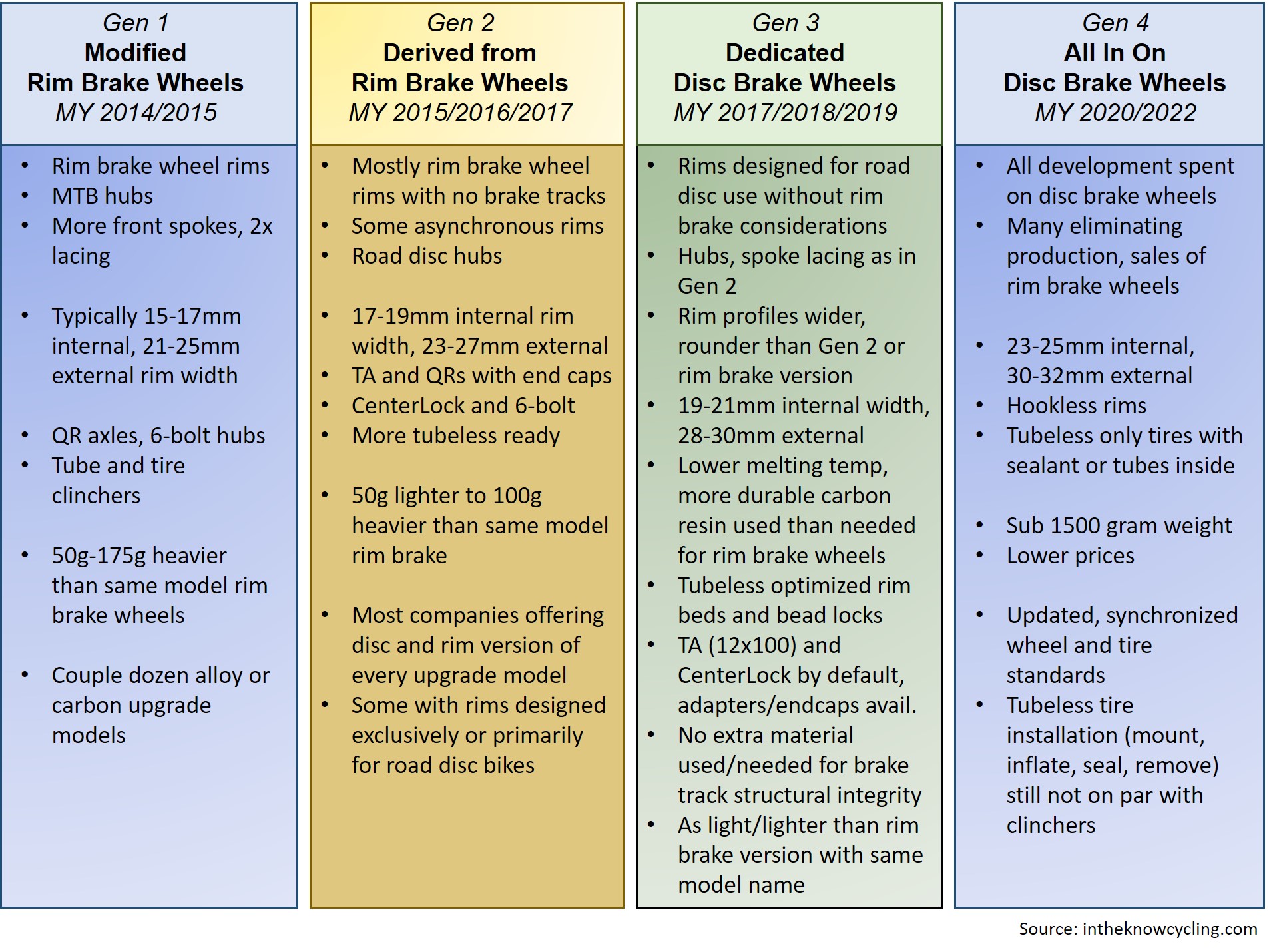
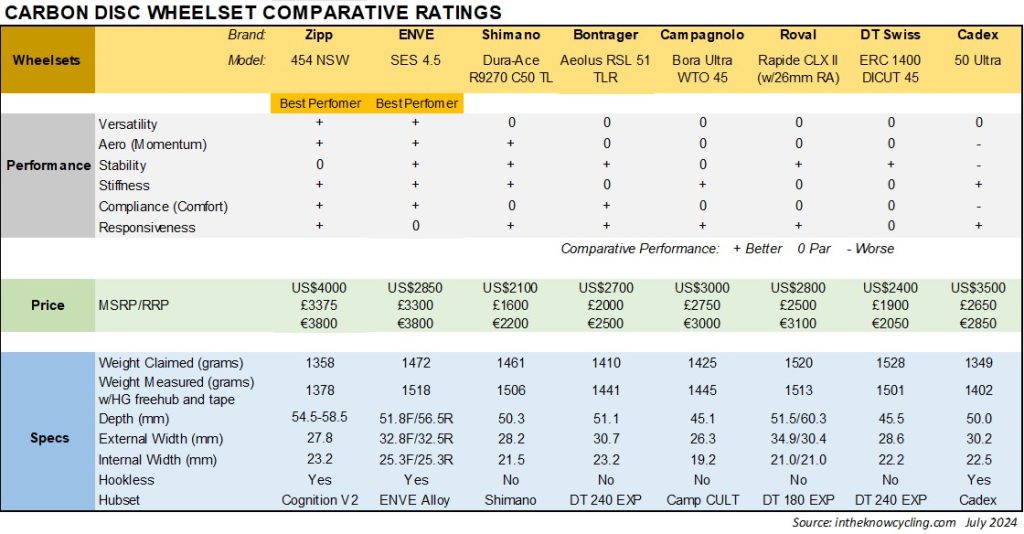
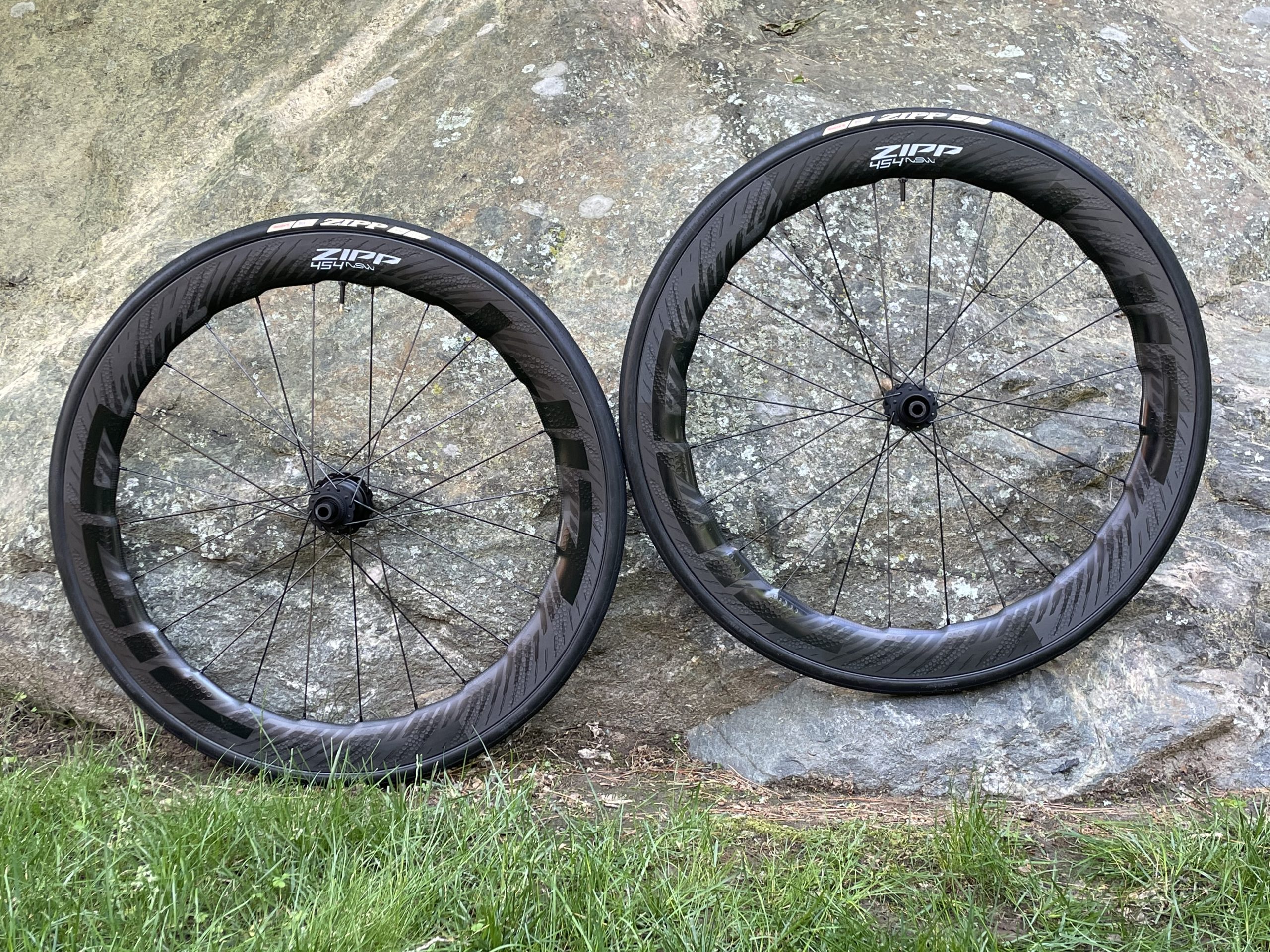

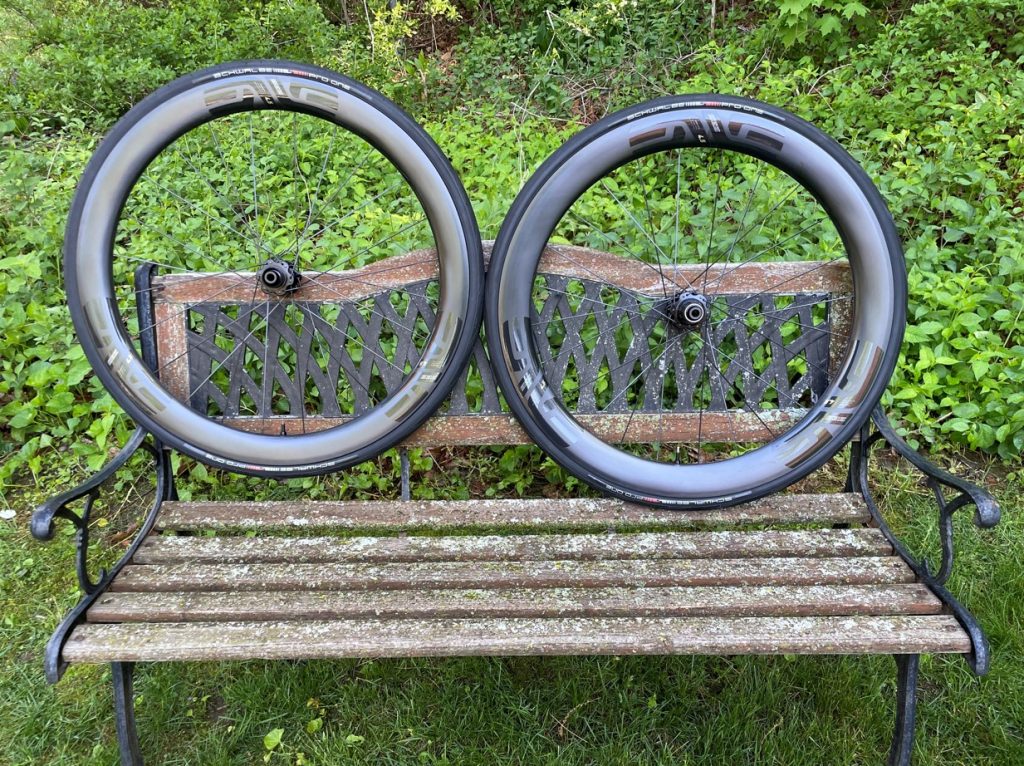
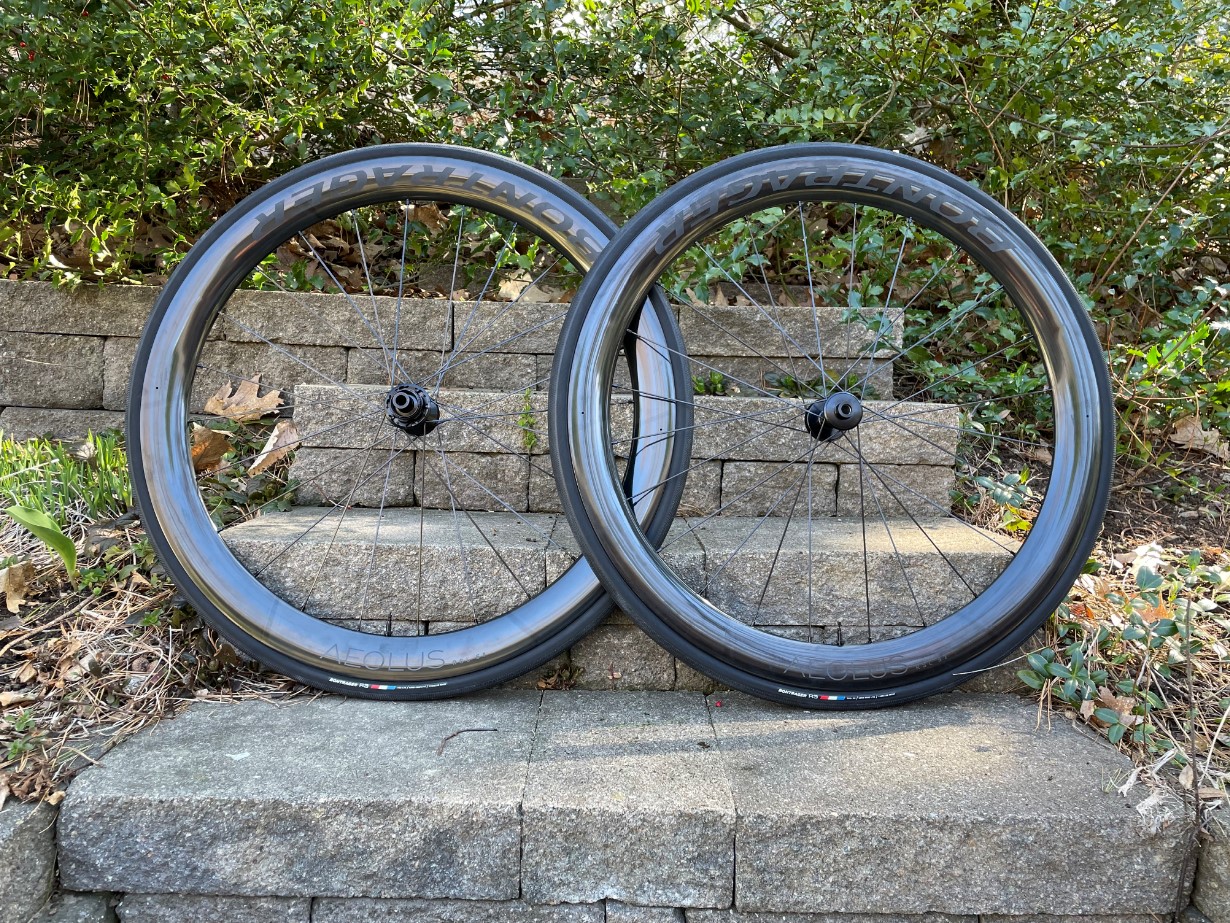
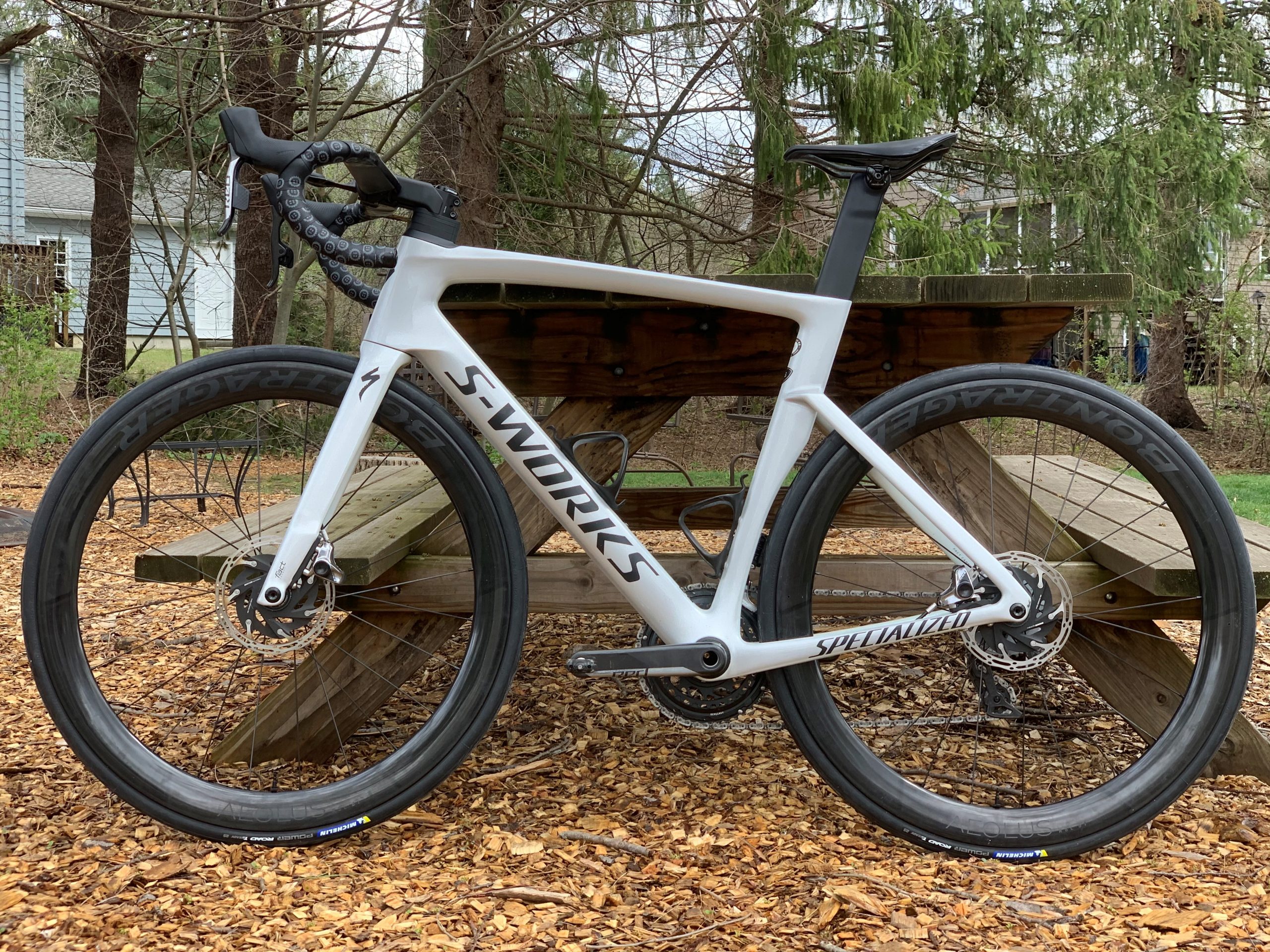
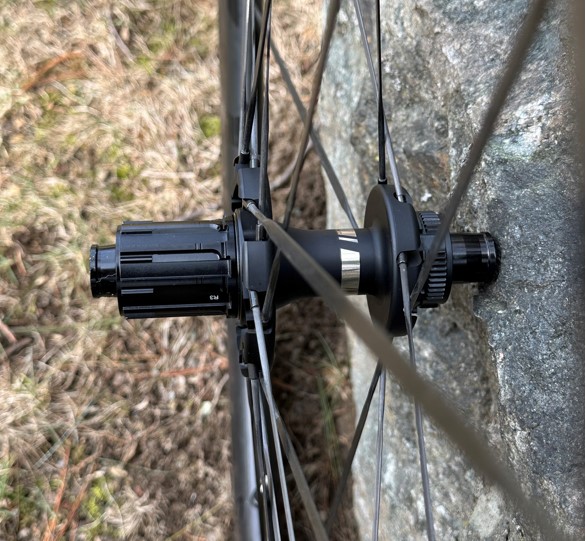
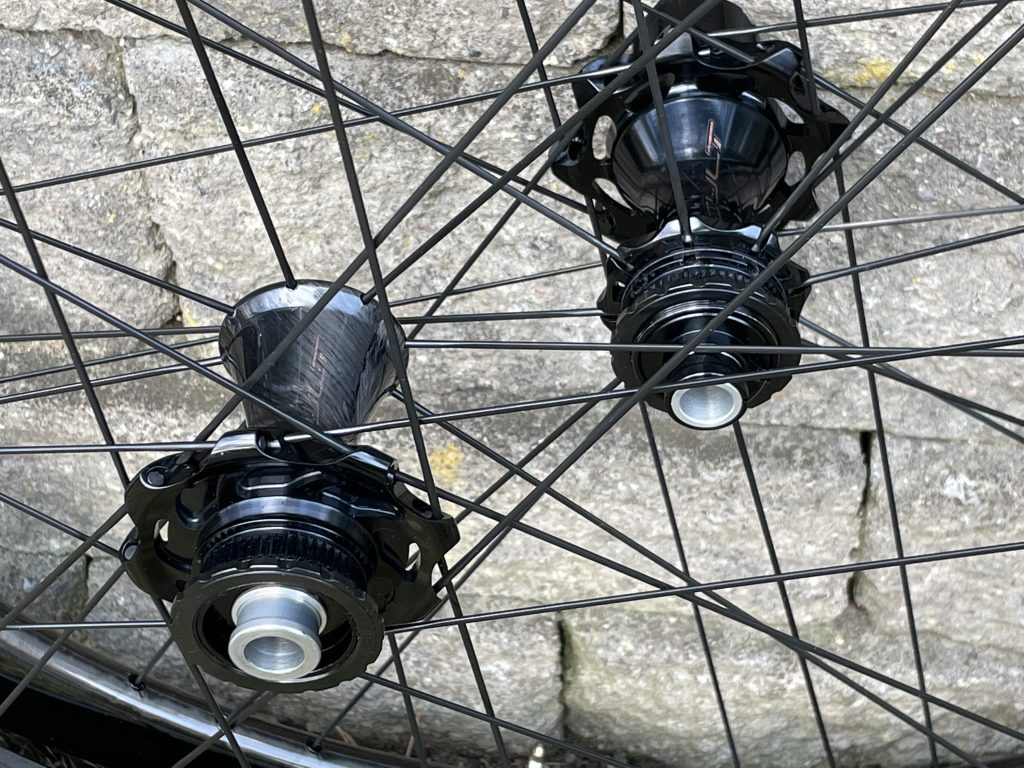

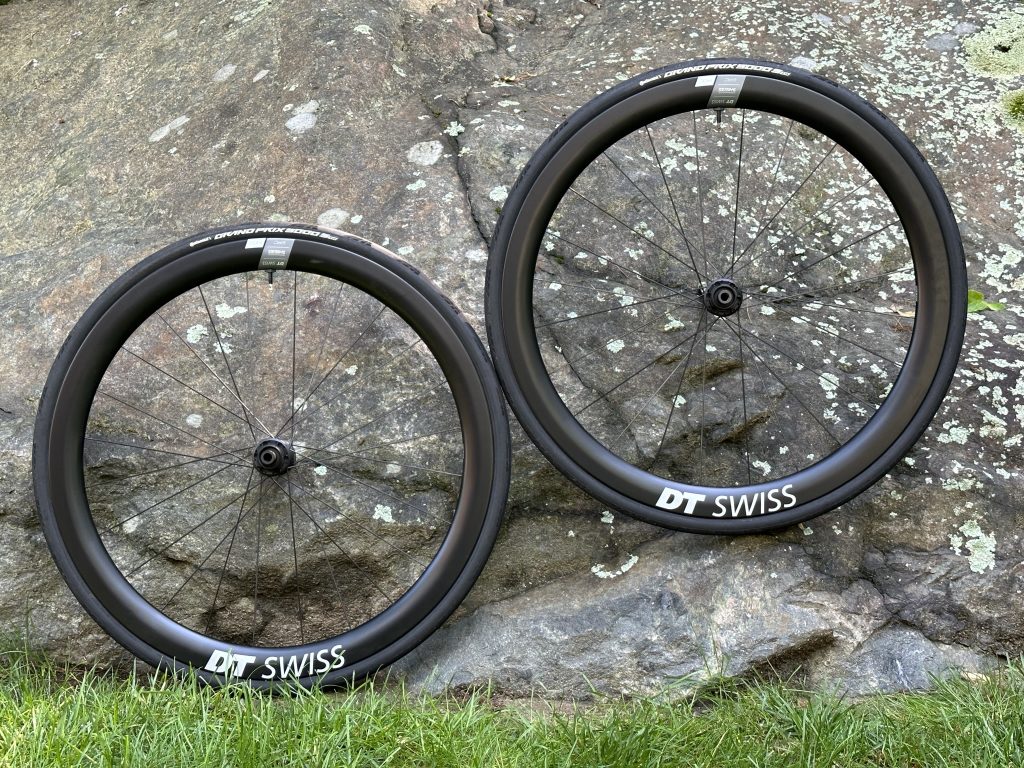
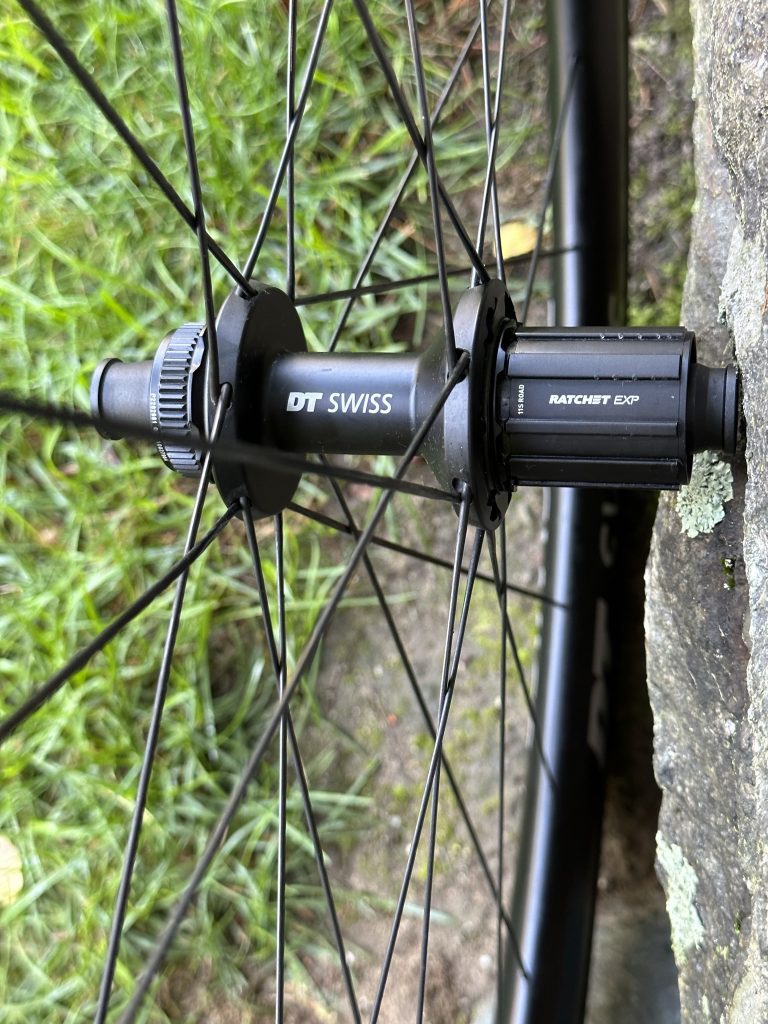


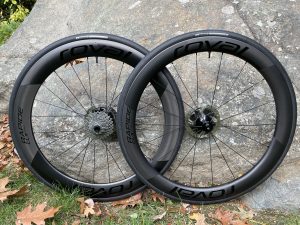
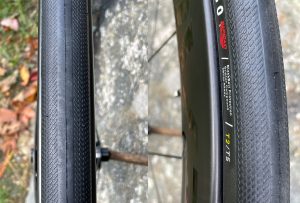
Did you happen to notice if the spokes on the RSL 51s, particularly the rear wheel, started pinging or creaking? I’ve owned a set for less than a year and the rear wheel makes a lot of noise, I took it to a Trek dealer and they said the spoke tension was fine and apparently this is a common issue with bladed spokes that touch where they intersect, I weigh around 205-210lbs so I’m sure that contributes as well. The wheels feel great and otherwise have had no issues but I was curious if anyone else had this happening with their wheels.
Steven, Didn’t notice this in our testing on these wheels. We notice this infrequently on other wheels the first few times we ride them and is usually a function of the uneven tension of the spokes. After a few rides, the pinging goes away after the tension evens out a bit. Contrary to what your dealer told your, this is not a common issue with bladed spokes on Bontrager or other wheels. If you dealer doesn’t have one, I’d take it to a shop that does have the tools to test and adjust spoke tension. Steve
Thanks Steve, I’ll take them to another Trek dealer.
Do the ratings (+,0,-) in their respective tables of the allround carbon wheels and value carbon wheels have the same absolute score? Reason for this question: the Bontrager Aeolus Pro 37 TLR costs nearly the same as the DT Swiss ERC 1400 DICUT 45 in Europe, but in your overview they are in different categories. My assumption from your informative reviews is that the performance is quite similar on the most important riding characteristics. Is this correct?
Background: The components on my old road bike became more and more obsolete (e.g. shifters, cassettes with the same teeth combinations and durability…), so I decided to buy a new bike. Having some herniated discs, I went for an in-depth bike-fit with as target: longer rides without lower back issues afterwards. The bike-fitter/kinesiologist/semi-pro-racer suggested that I decide on the groupset, not spend extra on the frame, but to upgrade with a good set of carbon wheels. So I have now an endurance bike (least changes to achieve the optimised riding position), a less aero riding position, but no back pain afterwards (so far…). Next step: trying to figure out what carbon wheels would bring to my advantage and which ones to buy.
Fortunately you created this excellent website. After reading ‘ride faster part 1 and 2’ and ‘how to choose’, my bike-fitters suggestion are confirmed and I have a good understanding of what to take into consideration.
Peter, the ratings are relative only to the wheels in the same table. Good to hear that the bike fit is enabling you to do long rides. Even at the same price, I find the Bontrager Aeolus Pro 37 TLR a bit more versatile on varying terrain and more responsive in acceleration and handling than the DT Swiss ERC 1400 Dicut 45. Hope that helps. Steve
Steve, thanks for the help. I got the Bontrager Aeolus Pro 37 TLR today.
According to the boxes, these are supplied to Trek by DT Swiss. So I guess that Trek Bontrager supply the rims to DT Swiss and that DT Swiss assembles the wheels in Switzerland. Thus, the hubs (and spokes?) do not have to cross the Atlantic twice.
Looking to purchase a wheelset to ride in Phoenix AZ. Typically flat riding with moderate wind conditions, group rides. I’m very interested in the Bontrager RSL 51, but have concerns riding with wheel rims of that depth and how they react with wind gusts. Everything that I have read claims wind gusts have little affect on these wheels.
Most people I ride with run rim depth of 45 or less and have concerns with 50 mm depth.
Are these concerns justified or should I buy them and take advantage of some new found speed.
Hi John, Those concerns were real with many rims of this depth 2 or 3 generations (5-6 years) ago and continue with some today. Some wheelsets in this review, including the RSL 51, are very stable in sidewinds. You can see ratings of the RSL 51 stability against others in the performance section of the comparative chart. https://intheknowcycling.com/carbon-disc-wheelset/#Ratings. If you live in a windy area, it’s important to get this right because variances in sidewind performance are far greater than the differences in aero drag when comparing wheelsets of the same depths, of different depths, and sold by different brands. I wrote about this and shared a lot of independent data about sidewinds in the second section of the part of another article this link will take you to: https://intheknowcycling.com/how-wide-wheels-wide-tires-make-you-faster/#I. Take advantage of new found, stable speed. Best, Steve
Steve, Aero advantage sounds great, but at my age 61 safety comes first. I’m now thinking that 40 mm range would be more practical for my riding. The search goes on.
Thanks for providing all this information!!
I truly love my ENVE SES 3.4, I agree with you they are a comfortable performer. Ride on Contis 28 never felt more comfortable, yet fast. I used them on my gravel bike for Unbound and, they performed so well compared to the Roval Terra CL that I refuse to swap back to my road bike.
Now I’m looking for a second wheelset, but want a different flavor. The Zipp 454 NSW and the ENVE SES 4.5 are high on my list and both on sale at BTD.
Are the ZIPP extra cash paying for only the extra 1% in performance compared to the ENVE SES 4.5? Or is it worth spending the difference?
TIA
Hi Miguel, Great to hear you had a good success with the ENVE SES 3.4 at Unbound. The 454 NSW will be a bit more responsive than the SES 4.5 which will be more stable in the crosswinds. Depending on what kind of terrain you ride and the weather around you, one would suit you better than another. If you ride in places with a lot of variable terrain – hills, rollers, climbs – but only seasonal winds – the Zipp 454 NSW will be a better choice. Windy, flatter terrain would favor ENVE SES 4.5. Steve
Hey Steve – long time follower and lover of the site
Any plans to review the Zipp NSW 353? I’m torn between 353 and 454s. Leaning towards the 454s though (even given their eye-watering price) – still love my old rimbrake NSW 404s i purchased based on your advice years back. Such great advice it was. They’ve since seen about 15,000 miles.
Hi JF, Wow, congrats on getting that much use out of of your 404 NSWs. Back at you. We reviewed the two in a this review https://intheknowcycling.com/zipp-454-nsw-review-zipp-353-nsw-review/ and compared the 353 against other climbing wheels here https://intheknowcycling.com/best-climbing-wheels/ and other all-road wheels here https://intheknowcycling.com/all-road-wheels/. Thanks for the follow and love. Feel free to show it (and support our ability to do these reviews) by buying whichever wheelset you decide on after clicking on one of the links to the stores I recommend in the review. Cheers, Steve
Hi Steve your review of Shimano DA C50 is very positive, you do make a comment that they do not hold speed or roll as well as Enve 3.4
This to me seems a bit surprising given Enve 3.4 is much shallower wheel. Are you saying that although C50 is positively aero, responsive and rolls wells on smooth surfaces it is still not rolling as well as an Enve 3.4? How does C50 then compare to Cadex 50 and RSL51 are they all worse rolling than Enve 3.4?
The C50 is much more competitively priced in UK compared to both cadex and Enve, basically half the price .
Eirik, Thanks for your comment. As the text now reads: “The C50 doesn’t quite carry speed like ENVE SES 4.5 or Zipp 454 NSW or roll as feathery as those wheels or the ENVE SES 3.4 and Zipp 353 NSW. But these Shimanos are right up there, just behind those sets.” I conflated holding speed and rolling in the original edit. I’ve fixed that now after reviewing Miles’ and Aiyana’s notes. Good catch!
And, as you can see in the comparative ratings, the C50 holds speeds better than the Cadex 50 and Bontrager RSL 51 and its prices in the US, UK, and EU are favorable compared to every other wheelset in the all-around category. Cheers, Steve
Hello Steve, than you so much for the confirmation and logical conclusion
As they say , it’s a no brainer!
C50 it is…
Hi Steve,
Always love your reviews. I have a set of the Campy Bora WTO 45 (19mm internal width) and while they are a good wheel in many regards, I have found that as the winds have picked up where I live they are getting blown around too much for comfort.
I have heard the ENVE wheels handle a crosswind better, is that your experience and is it significant enough to switch? I live in a mountainous region with lots of sharp punchy climbs and ride 30 kph avg over the mostly rolling terrain, would the SES 3.4 or 4.5 be a better choice if they are worth the switch?
Darrin, Thanks for your kind feedback. On the wheels, yes, ENVE SES 4.5 are notably more stable in sidewinds than the Campy Bora WTO 45s you have. The SES 3.4 is also very stable in cross winds. The 4.5 will carry your momentum a bit better but the 3.4 will climb a bit better. If the climbs you are doing are short or not to steep (<7%), aero will be more important. Longer or steeper climbs will favor the lighter wheelset. If you're averaging 30kph on rolling courses, you're also probably riding a fair amount of your time >30kph where the aero benefit again will favor the 4.5. You also might want to check out our review of the 3.4 which adds some context about who the wheelset might best suit. Steve
Super write up thanks. I currently run 35mm hollowgrams (cx ray spokes) & 25mm clinchers on my cannondale synapse but not being as fast as I used to be and with a bad back and our terrible English roads I am thinking of looking for a comfortable aero carbon wheelset designed for 28mm tubeless that won’t break the bank for all round recreational riding. Just spent a week doing 60mile rides around lake Annecy. Do you think the DT Swiss 1400 would fit my bill best? Or something else? I could put 28mm tubeless on my hollowgrams but they will bulge out beyond the rims which look to be about 26mm external. Thanks
Btw I am around 64kgs. Used to be a good climber (cat 2/1 racer) but now it’s more about comfort at a reasonable pace.
Russell, That wheelset could work for what you’ve described. Other less expensive options are here: https://intheknowcycling.com/best-value-carbon-wheelset/. Steve
Many Thanks Steve. Interesting options although still drawn to the dt1400’s which I can get for around £1400.
Hi Steve, have you had a chance to try out the new hunt wheel? HUNT SUB50 LIMITLESS AERO DISC WHEELSET With steel spokes ?
It seems on a similar par to the DT Swiss 1400 but tubeless only & wider rims ?
Russell, I haven’t tested that wheelset. We have tested other Hunt wheels including the https://intheknowcycling.com/hunt-limitless-48-aero-review/. You can always use the search box at the top of the page to see if we’ve done a review of any wheelset you’re interested in. Steve
28 isn’t wide at all these days. I guess it’s ok if you weigh 100 lbs. Plus I’m not about to buy hookless. The advantage to those are only because they are cheaper and easier for manufacturers to make so they make more profit. If you have to consult a list of tires that are safe for your wheels that’s a huge red flag. I frankly have no idea why people are ok with this. I’d say 32 is the sweet spot for most people these days. It was for me but now I’m riding 35 tubeless and love it. I’ve been riding road bikes since the early 80s and remember 25c tires at 110 psi or even higher…lots of things were different about wheels and tires back then. Now I’m running Roval Terra CL’s with 32c GP All Season setup tubeless on my road bike and love it. I think recommended psi is around 60 but I’m doing 65. I’m 6’2” and a big guy in general.
Steve, great review, especially nice to follow the history of wheel development. Thans for this!
Hi Steve,
Thank you for all the work done on the website. This is interesting to read :).
I a currently riding Canyon Ultimate CF SLX with DT Swiss ARC 1400 50mm which I would like to improve by more dynamic, lightweight all around wheelsets.
I have been looking at the new DT 1100 in 38mm but I see that they are a bit old fashioned with their internal width. Enve SES & Zipp look appealing but a bit above budget.
What is your opinion on the new Mavic Cosmic SLR 45mm updated with an internal width of 23 mm ?
Thanks a lot 🙂
Florian, Thanks for your kind feedback. I haven’t tested the new Mavic wheels so I don’t have an evaluation of how they’d accelerate – the “dynamic” or responsiveness characteristic you’re looking to improve upon – any better than your current DT Swiss wheels. Weight is only one factor in how well a wheel accelerates. The rim’s weight (vs. the wheel’s weight), carbon layup, spoke material, lacing, hub flanges, how they’re assembled, etc. all combine in determining how dynamic or responsive a wheelset will be. Depending on what kind of riding you do, the Shimano and Bontrager we reviewed are also quite responsive and they cost a good deal less than the Zipp and ENVE, certainly if you’re paying in Euros. I wouldn’t get hung up on the specs – internal width, weight, depth, etc. They don’t define how a wheel rides out on the road as well as the testing we do during actual road riding and racing. Steve